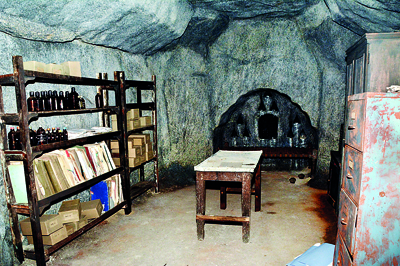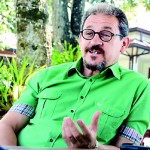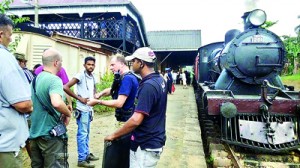Lanka’s role in the return of Jekyll
View(s):A new ITV mini- series, ‘Jekyll & Hyde’, based on the classic but with a twist, is set partly in Ceylon of the 1930s. Here Duvindi Illankoon meets the men behind the scenes
It’s past noon and we’re desperate for a picture. Yet the guards at the Bogambara Prison will have none of it. After countless phone calls, and an unexpected mini sand storm, they relent and allow us a tiny peek through the gate. If there ever was a perfect setting for this story, Bogambara is it. It’s abandoned, haunted vibe is perfect for the grim, eerie backdrop of ‘Jekyll &Hyde’ , a television mini-series shot in Sri Lanka.
It’s a Saturday in Kandy and Executive Producer Foz Allan is kind enough to sit down with us on his one off-day in ages and give us an idea of

Hidden away: The bunker set at Bogambara. Pix courtesy The Film Team
what the show is about. It’s a series commissioned by ITV, the same network that produces Coronation Street, Emmerdale, Agatha Christie’s Poirot and most recently, The Great Fire. The script was written by Charlie Higson, who penned King of the Ants, the Enemy novels and Young Bond. The show is directed by Colin Teague, of Being Human fame. Allan previously produced shows like Robin Hood and Casualty.
Unlike the original novel by R.L. Stevenson ‘The Strange Case of Dr. Jekyll and Mr. Hyde’, this show is set in the 1930’s and follows Jekyll’s grandson Robert whose foster father is a doctor based in Ceylon. The exact nature of Robert’s presence in Sri Lanka is sketchy, although Allan tells us that his very existence is a well-kept secret. “We’re saying that Dr. Jekyll had a son, who passed on the gene to his son,” he explains. “We’re also saying that the Hyde aspect is passed down through their DNA, and the drug – instead of turning him as it does in the book- is actually what releases him from the demons.”
The novel speaks of Jekyll’s demons, that much debated mystery which has made this tale, the horror genre’s most adapted story of all time. There are over 123 film versions alone. Its enduring popularity is perhaps due to its accessibility-“we all have another side that society doesn’t meet,” points out Allan. The script’s family entertainment value was highly prized by the network, he says. “We’re looking at what they call primetime in the US and what we, in the UK, simply call family audiences.”
Higson’s original script was based in India, where Robert begins his journey. Allan visited India to scout out locations, but was put off by the grey monsoon skies.

Executive producer Fox Allan
“We needed a place very different to grey, industrial London,” he notes. So Sri Lanka was picked for her undeniably blue skies- and easy access to steam engines! For a story set in the ‘30’s, they were practically a prerequisite.
Several scenes were shot at the Rambukkana train station with extensive logistical support from The Film Team in Sri Lanka led by Ravindra Randeniya. “We offered locations in Sigiriya and Kandy,” says Gopi Darmaratnam of The Film Team. “The successful scouting and the discussions our Art Director (Errol Kelly) had with the Director led them to make the change in the script from India to Sri Lanka as they were very keen on showing historic and touristic places like the Sigiriya Rock fortress in the shoot. The new script was submitted to the National Film Corporation for approval.”

The Dunuwila village set: Scene of the medical clinic and major crash
To their disappointment however Sigiriya was deluged, so the crew had to move to Kandy led by Errol Kelly, perhaps Sri Lanka’s best-known Art Director and certainly one of her finest. Errol has previously worked in big-budget films such as Steven Spielberg’s Indiana Jones and more recently in Deepa Mehta’s Water and Midnight’s Children. “We were building a village in Sigiriya when the rains started and the entire set went underwater,” Errol recalls. “So in 10 days we relocated and built our set in Dunuwila.”
Dunuwila was the main set, being the background for a village medical clinic that Robert’s fosterfather visits every month. It was also the setting for an elaborately choreographed scene involving a truck crashing into the clinic, and the hero saving a villager. This is when the hero and his nemesis realise that his powers are no freak accident. Robert is immediately pursued, and watched by an organisation known as the MIO, or ‘the invisible men’.
Tom Bateman plays Robert Jekyll, while Richard E. Grant, Natalie Gumede, Donald Sumpter, Enzo Cilenti and Christian McKay take on other lead roles. Bateman is fresh off a critically acclaimed performance as Shakespeare in West End’s Shakespeare in Love, and “has a very charismatic presence that he can instantly change to become someone else,” says Allan. “He’s a bit like that Jaime Lannister from Game of Thrones – you can’t help but like the guy.” In fact, both Sumpter and Clienti play significant roles in the latter show. Sumpter played Maester Luwin, while Cilenti will play Yezzan in the upcoming season of the series.
“We’ve been enjoying the food here,” says Allan of their time in Sri Lanka. “It’s been…legendary.” When we meet the producer, the cast are taking a well-deserved day off from their two week filming schedule, and are nowhere in sight. Tom Bateman, a quick Twitter investigation reveals, has been hanging out with the monkeys.
Allan declares himself pleased with production so far. “When a production goes to a foreign environment you need people on set who know the place like the back of their hand. My London crew is great in London, but in Sri Lanka we needed a local team on set too. Shooting has been fun-we’ve just wrapped up a fighting scene and tomorrow (January 25) we shoot at the Rambukkana train station with the steam engine.”
The steam train at Rambukkana station proved a logistical nightmare. It was a tough location to shoot, say the team, as they had to ensure that the railway authorities and public would not be inconvenienced. “We planned these shoots very carefully,” says Errol. Shoots were planned well in advance to make maximum use of the time given, and each time a train was on its way, the steam train would be moved and then repositioned for filming. Line Producer Ainsley De Silva along with Location Manager Sameera Randeniya were instrumental in making this possible.

Rambukkana station: Chugging back in time to the age of steam engines
Bogambara proved much easier, they say, to our surprise. The 138-year-old prison was closed to the public last year, after the inmates were moved to Pallekele. The intense stillness of its abandoned grounds provided an apt background for three sets-a rural post office, the police superintendent’s office and a bunker.
Capturing colonial Ceylon meant everything had to be designed carefully from scratch. “We referred a lot of old photographs and books,” says Errol. Darmaratnam adds “This meant the sets, set dressing and props, wardrobe, makeup and hair – everything except for the elephant-had to fit into the period.” The technicians were given ample opportunity to work with their counterparts from the UK. The locals in the villages they worked with also benefited in their own way- a doctor on set was happy to examine them, and the team plans to buy a much needed water pump for one village.
Filming in Sri Lanka has ended (the last scene was shot in a temple last Thursday) and the crew has flown back to London for the next phase of shooting. Jekyll & Hyde has been commissioned for 10 episodes by ITV, and its producer expects a positive response from audiences and perhaps another season too. It’s rare that you find such vibrantly intelligent shows, he says of the show’s premise, and the script seemed a natural choice for a growing audience who seem to like the villain-turned-hero tale. After all, he laughs, “Us Brits do villains and bad guys best!”


